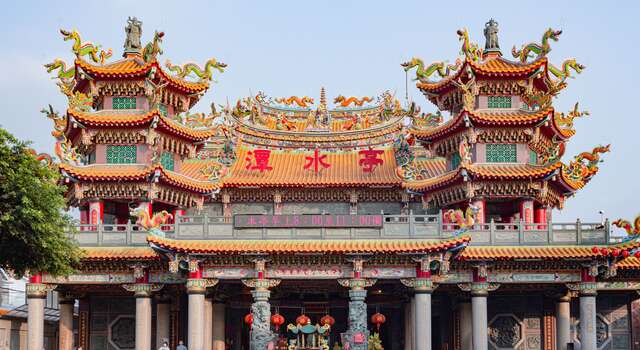Tan Shui Pavilion Introduction
Tanshui Pavilion (having a history of over 200 years) is located in Tanyali, Tanzih District, Taichung City, and serves as the center of belief for the area. During the Qianlong era, the wooden-root Guanyin floated to Xiatanzi, glowing at night; thus, the ancestors built a small stone temple under the bamboo forest by the pond as a place of worship. In the sixth year of the Jiaqing reign (1801), the villagers, recognizing the growing number of believers, pooled resources to build a pavilion by the pond for "Tanshui Pavilion," which marked its beginning. In the fourth year of the Daoguang reign (1824), it was renovated, and the villagers established a plaque to commemorate it. By the fourth year of the Guangxu reign (1878), with donations from Lin Qinchun of Dapu Village and others, the pavillion continued to be maintained and expanded. The temple has since remained intact with a steady stream of devotees. In the ninth year of the Republic of China, a flood damaged the temple's walls and beams, prompting villagers such as Lin Qiongzhang and Fu Jieqi to advocate for relocating the temple, with Lin Fengyuan donating land for the new temple site. It was rebuilt in April of the same year, completed by the twelfth year of the Republic of China. In the fifty-seventh year of the Republic of China, due to frequent leaks in the tile roof, local gentelman Dai Chunbo initiated fundraising for repairs, and generous donations from devout individuals, including Wu Tian, provided land for roads to facilitate access for devotees and vehicles. The renovations and expansions were completed by the winter of the sixty-fifth year of the Republic of China, and a management committee was established in the seventieth year. After another half-century, Chairman Dai dedicated himself to fundraising, and in the eightieth year, purchased 11 residential houses behind the temple, redesigning them into the Grand Hall, which was completed in the ninetieth year. During the years of 1993, a repair team was established to address persistent leaks in the original rear hall and side rooms, which were demolished and expanded into a central hall, retaining the main hall (Guanyin Hall) as a rare temple within a temple structure. In May of the ninety-sixth year, 160.8 ping of land was purchased for the temple courtyard, completed by the end of the ninety-sixth year, resulting in the current appearance of the temple. The "Tanshui Pavilion" expansion project was completed between January 2005 and July 2008. The front hall of Tanshui Pavilion enshrines Guanyin Bodhisattva, along with Shancai Dragon Girl. The magnificent "Water Flowing Guanyin" is also enshrined here. The second floor of the rear hall is dedicated to Shakyamuni Buddha, Bhaisajyaguru, Amitabha, Manjushri, Samantabhadra, Protector Weituo, and Kṣitigarbha. The sides host the Eighteen Arhats and the Wall of Ten Thousand Buddhas. The first floor enshrines Kṣitigarbha and the Wall of Ten Thousand Buddhas. The third floor of the central hall is dedicated to the Jade Emperor, the second floor to San Guan Da Di, Shennong Da Di, Xuantian Shangdi, Doumu, and the stars of the Northern and Southern Dippers, as well as the 60-year cycle Tai Sui. The first floor includes Tian Shang Sheng Mu, Guan Sheng Di Jun, Zhi Sheng Niang Niang, Zhi Sheng Xian Shi, Wenchang Dijun, Qiao Sheng Xian Shi, Chenghuang Ye, Si Ming Zhen Jun, Fude Zheng Shen, and Zhongtan Yuan Shuai, with conference rooms, offices, and service counters on both sides. Tanshui Pavilion covers a vast area, with magnificent temple architecture, serving as a solemn and beneficial place for preaching and living. Its structure is intact and rich in ancient charm, complemented by a green-tiled cultural corridor (now dismantled) at the north end, and a quaint hexagonal pavilion at the southwest, with greenery flourishing around it, making it a cherished site for the villagers and a favored place for prayer and blessings today. Source: Tanshui Pavilion Guanyin Temple.

































